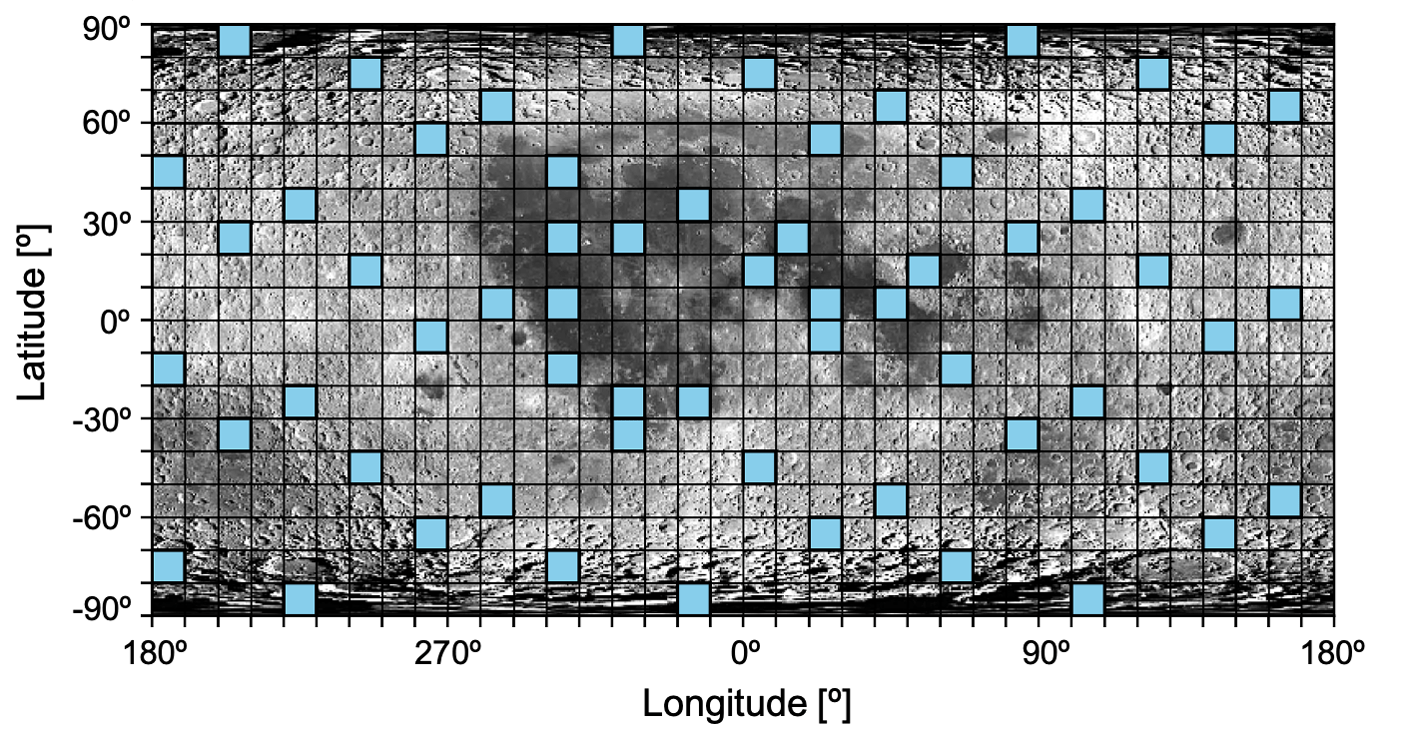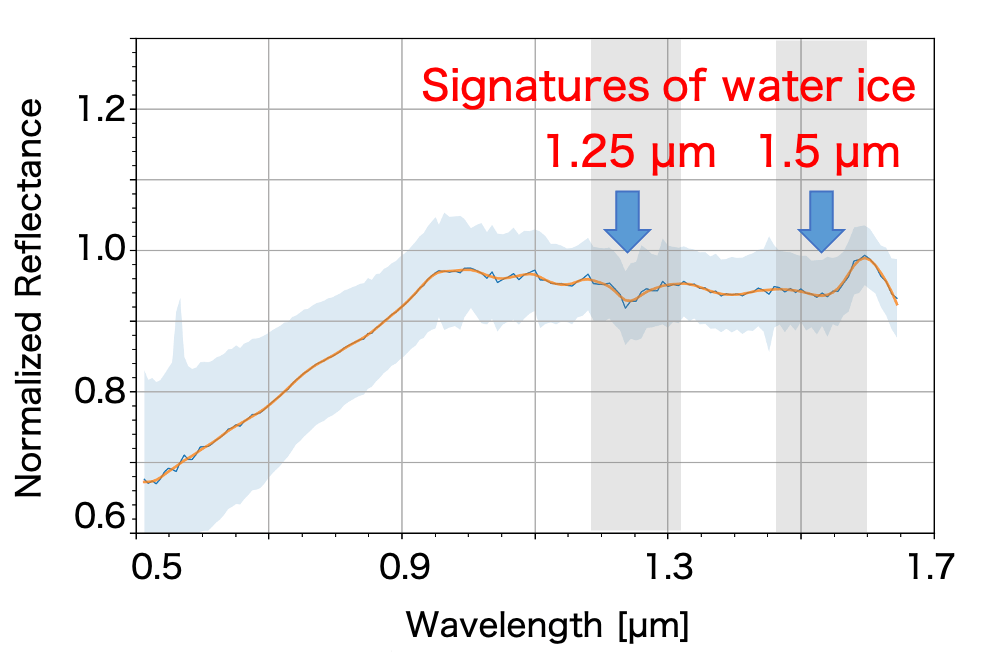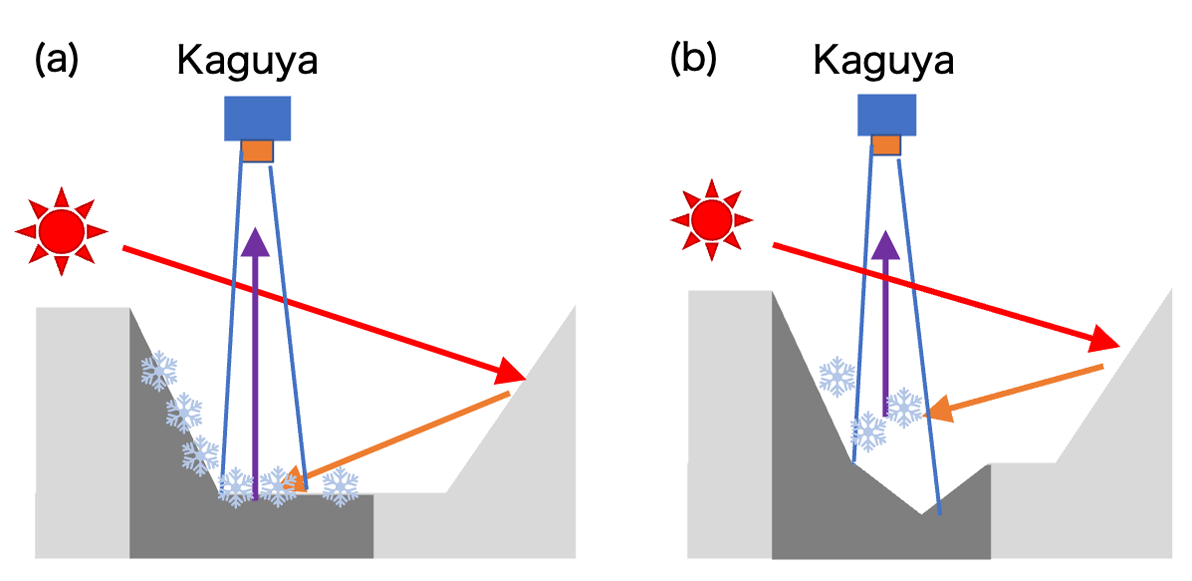SELENE (Kaguya) spacecraft detected water ice in lunar shadowed regions: confirmed across various latitudes and local times!
Feb. 19, 2025 | GATEWAY to Academic Articles
The Moon is the closest celestial body to the Earth and preserves information from the early Solar System. Understanding the evolution of water environments on the Moon can therefore contribute to uncovering the origins of the Earth's water. Previous studies have suggested that water on the Moon undergoes significant migration, spanning hundreds of kilometers, within a single lunar day (approximately one month on Earth). Theoretically, such migrating water is expected to adsorb efficiently onto the surfaces of cold shadowed regions at various latitudes. However, its actual state and quantity have remained poorly understood.
In this study, we analyzed near-infrared spectroscopic data from JAXA's lunar orbiter "SELENE (Kaguya)" to investigate the state of water in shadowed regions across various lunar latitudes. Our findings revealed, for the first time, the presence of water ice particles in shadowed regions at mid-to-low latitudes, including near the lunar equator. This discovery supports the notion that water exists not only in permanently shadowed regions at the lunar poles but also across the Moon's surface, with ongoing migration even today. These results provide new insights into the distribution and origin of lunar water.
Research Summary

The Moon, as Earth's closest celestial body and a repository of information from the early Solar System, holds significant clues to the origin of water on Earth—a question that remains unresolved. Since the Apollo program, the Moon was long believed to be devoid of water. However, over the past 15 years, numerous studies have revealed that the Moon contains significantly more water than previously thought.

Due to its high volatility*1, water on the lunar surface which supports only a very thin atmosphere, undergoes repeated cycles of diffusion and adsorption. It is believed that these processes enable water to migrate over distances of hundreds of kilometers within a single lunar day (approximately one month on Earth). Given that the Moon's water environment continues to evolve, understanding these migration processes in detail is crucial to reconstructing the Moon's early history and shedding light on the origin of lunar water. Although previous studies have theoretically predicted that migrating water is predominantly adsorbed in cold shadowed regions at various latitudes, the actual state and quantity of water in these regions remain poorly understood.
To clarify the state of water in shadowed regions at various lunar latitudes and enhance our understanding of water migration processes on the Moon, this study analyzed near-infrared spectroscopic data from JAXA's lunar orbiter SELENE (Kaguya)*2.

Since water absorbs light in specific wavelengths in the near-infrared range, near-infrared spectral data*3 are critical for investigating the presence of water. This study focused on data obtained by the Spectral Profiler (SP)*4 onboard Kaguya, which features less noise and higher spectral resolution compared to data from other lunar orbiter’s data. These advantages allowed us to investigate water distribution in dark shadowed regions, a task previously considered challenging.
We analyzed SP data from 60 areas, each measuring 10º latitude by 10º longitude and covering diverse latitudes, longitudes, and geological backgrounds. Spectral features indicative of water ice were identified in shadowed regions at various local times across all analyzed areas (Figures 1, 2). The observed spectra showed no absorption features corresponding to major lunar minerals, suggesting that ice frost covers the surface of these shadowed regions or that ice particles exist above the surface (Figure 3). Furthermore, the estimated ice abundance ranged in approximately 10-4–10-3 [kg/m²].
This study is the first to confirm the presence of water ice not only in the permanently shadowed regions*5 at the lunar poles but also in shadowed areas at various latitudes. These findings are expected to significantly advance our understanding of the origin and migration mechanisms of lunar water. In addition, as lunar landing missions by various countries and private companies continue to increase, this research also emphasizes the importance of detailed investigations into water distribution, not only in polar regions but also in mid- and low-latitude regions.
Terminologies
- *1 Volatility: The tendency of a substance to easily evaporate and turn into a gas.
- *2 SELENE (Kaguya): A lunar orbiter launched by JAXA in 2007. Equipped with 15 scientific instruments, it conducted observations until 2009.
- *3 Near-infrared spectral data: Data representing the reflectance (the ratio of reflected light) of sunlight reflected from the lunar surface in the near-infrared range (wavelength: 0.7–2.5 µm). Since water and certain minerals exhibit unique absorption features in the near-infrared spectrum, such data are used to investigate the compositional distribution of celestial surfaces.
- *4 Spectral Profiler (SP): A near-infrared continuous spectroscopic observation instrument onboard Kaguya, designed to reveal the composition of the lunar surface. It features a high spectral resolution of 6–8 nm and less noise levels compared to data from other lunar orbiter’s data.
- *5 Permanently Shadowed Regions: Areas located within craters near the lunar north and south poles that is never illuminated by sunlight, even during the daytime. Due to the absence of sunlight, these regions remain consistently at extremely low temperatures (approximately -170°C or lower).
Information
| Journal Title | Earth and Planetary Science Letters |
|---|---|
| Full title of the paper | Water Ice Particles detected by SELENE’s Spectral Profiler at Lunar Shadowed Regions in Various Local Times and Latitudes |
| DOI | https://doi.org/10.1016/j.epsl.2024.119065 |
| Publish date | 15 October 2024 (online), 15 December 2024 (publish) |
| Author(s) | Kosei Toyokawa, Junichi Haruyama, Takahiro Iwata, Hitoshi Nozawa |
| ISAS or JAXA member(s) among author(s) | TOYOKAWA Kosei (Department of Solar System Sciences, ISAS/JAXA), HARUYAMA Junichi (Department of Solar System Sciences, ISAS/JAXA), IWATA Takahiro (Department of Solar System Sciences, ISAS/JAXA), NOZAWA Hitoshi (Department of Solar System Sciences, ISAS/JAXA) |


 TOYOKAWA Kosei /
TOYOKAWA Kosei / 